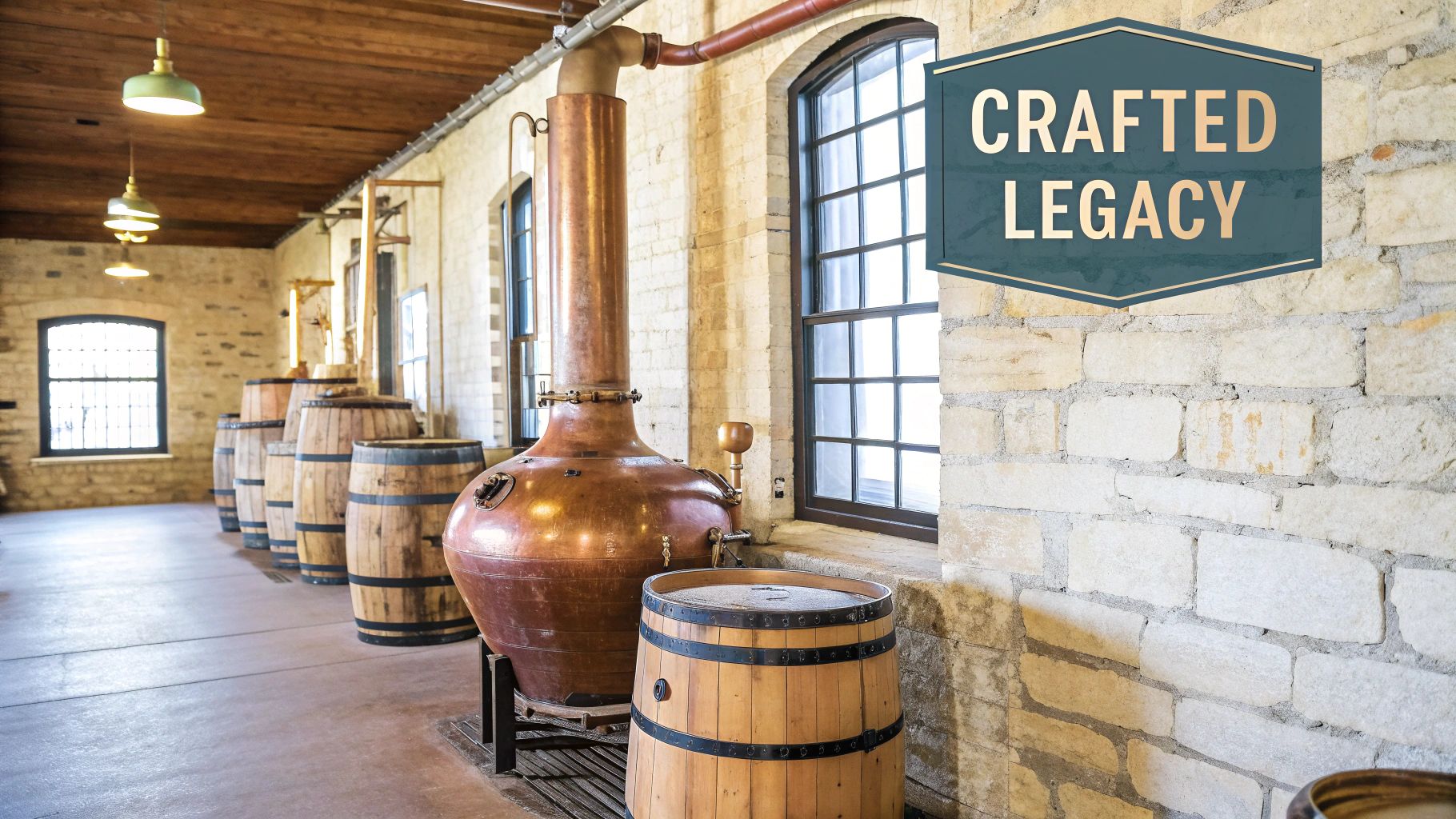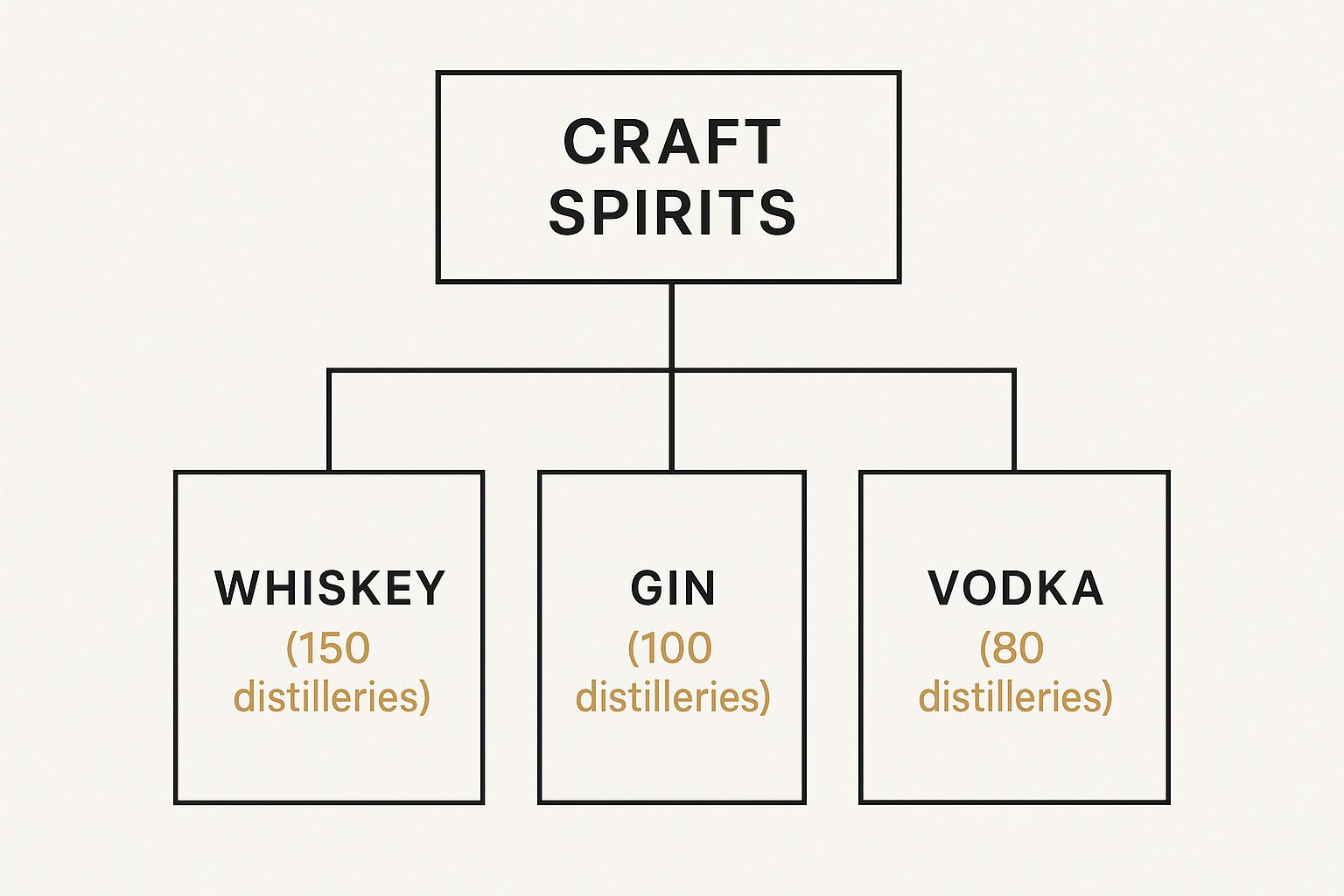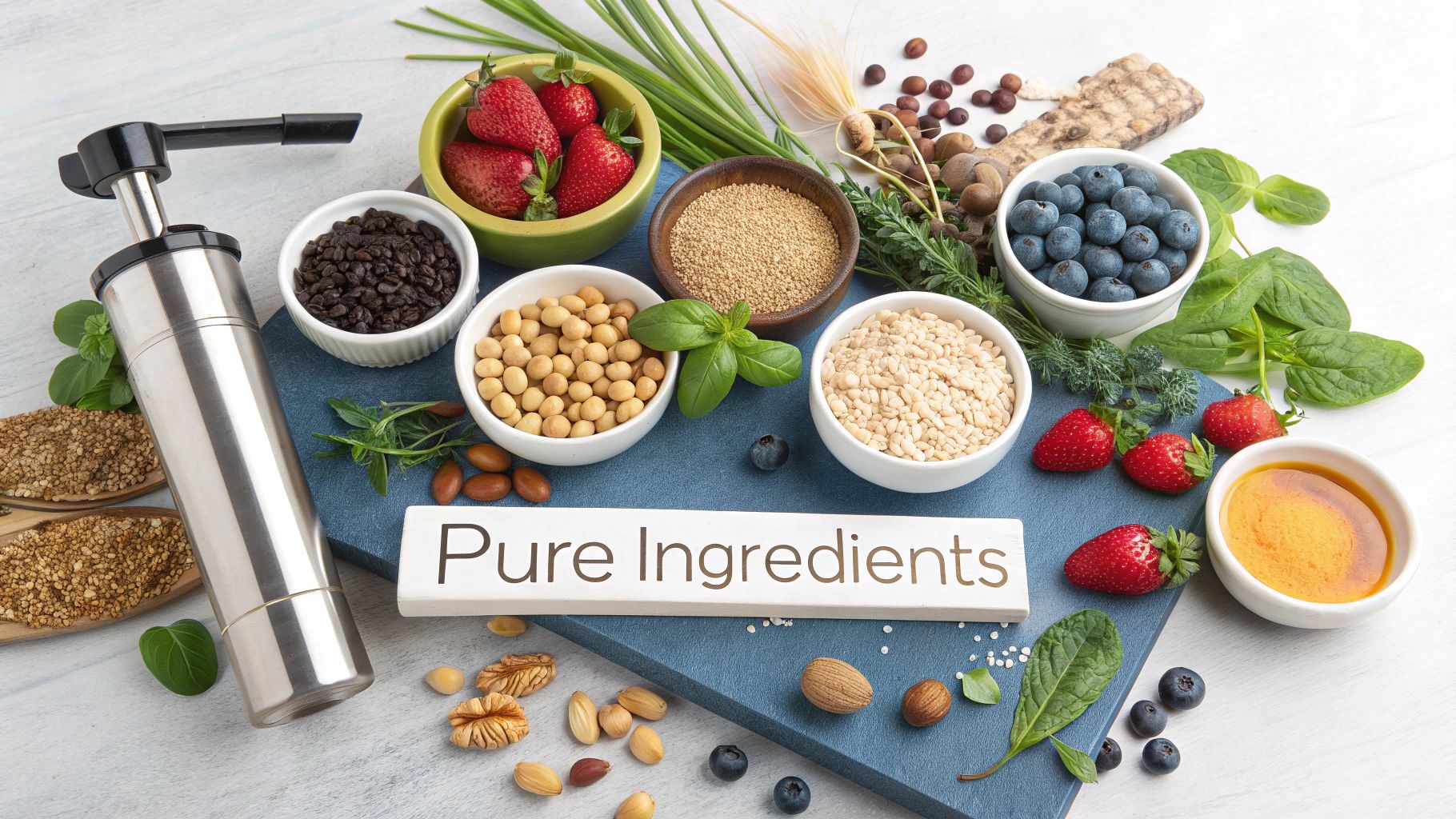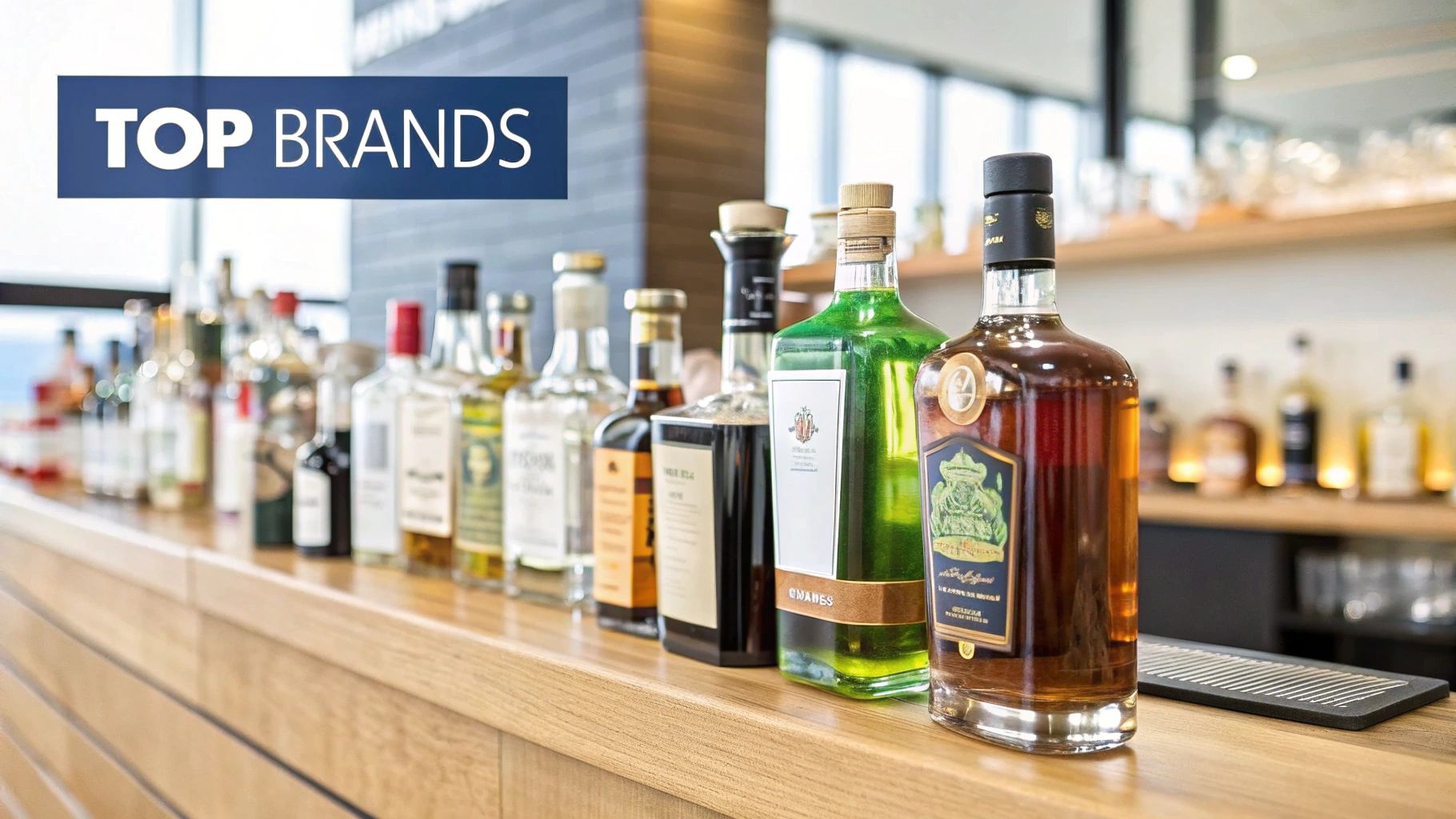If you’re on the hunt for great American craft spirits, you’ve probably noticed the action is happening at the small, independent distilleries. These are the places where flavor and passion are bottled, where producers choose quality over quantity every time. They’re creating authentic spirits, especially American craft whiskey, that tell a story about local ingredients and hands-on artistry.
The Rise of American Craft Spirits

It wasn’t all that long ago that the spirits landscape was dominated by just a handful of massive brands. The shelves looked pretty much the same from coast to coast, offering consistency but not much in the way of local character or real innovation. But then, a major shift started happening, a lot like what we saw with the craft beer and farm-to-table food movements.
People began craving more than just a familiar label. They wanted a real connection to what they were drinking. This growing hunger for authenticity, quality ingredients, and unique stories sparked a true renaissance in small-scale distilling. This whole cultural phenomenon, which you can read more about in our guide to the rebirth of American craft whiskey, is all about celebrating the distiller's art.
From Niche Hobby to National Movement
What started with a few passionate artisans has exploded into a powerful national movement. It’s a profound change that mirrors the craft brewing boom. Back in 1978, there were only 89 breweries in the entire country. As that number skyrocketed, it paved the way for a new generation of distillers to follow suit.
Today, with over 3,000 active craft distilleries across the U.S., the movement is undeniable. By 2020, craft spirits had already captured 7.1% of the market by value—a huge jump from just 3% in 2015.
This entire movement is really built on a few core principles that set these producers miles apart from their mass-market cousins:
- Hands-On Production: Distillers are intimately involved in every single step, from hand-selecting grains to making the final, crucial cuts during distillation.
- Innovation and Experimentation: Craft producers are the ones taking risks. They’re playing with unique heirloom grains, unconventional aging processes, and bold flavor profiles that the big guys wouldn't touch.
- Community Focus: Many of these distilleries are deeply rooted in their local areas, prioritizing nearby ingredients and building strong connections within their communities.
At its heart, the craft spirits movement is about rediscovering tradition while simultaneously pushing the boundaries of what's possible. It’s a return to appreciating spirits for their complexity, their character, and the human story behind each bottle.
For anyone new to the world of whiskey, this is an incredibly exciting time. Instead of one dominant flavor profile, you now have access to a dizzying array of bourbons, ryes, and single malts that reflect the unique vision and local terroir of their creators. It makes the journey of discovery all the more rewarding.
What Truly Defines a Craft Spirit
So, what’s the real difference between a craft spirit and the mass-produced bottles you see lining every grocery store shelf?
Think of it like comparing your local artisan baker to a giant commercial factory. One obsesses over every single ingredient, knows the farmer who grew the wheat, and kneads every loaf by hand. The other? It’s all about volume, consistency, and efficiency. That same soul and hands-on philosophy is exactly what drives the world of great American craft spirits.
At its heart, a craft spirit is all about a deep-seated commitment to quality, transparency, and a process you can actually put your hands on. It’s not just some fancy label—it's a whole approach that guides every decision, from picking the grain to sealing the final bottle. This is what gives each spirit its own unique character and a story worth telling.
This chart breaks down the most popular spirit types among today's craft distilleries.

As you can see, American craft whiskey brands lead the pack by a wide margin, proving just how central whiskey is to the entire craft movement.
Craft vs. Mass-Market Spirits: A Quick Comparison
To really nail down the differences, it helps to see them side-by-side. This table breaks down what separates the small-batch artisans from the industrial giants.
| Attribute | Craft Spirits | Mass-Market Spirits |
|---|---|---|
| Production Scale | Small batches, often seasonal | Massive, continuous production |
| Ownership | Independently owned, often by the distiller | Owned by large multinational corporations |
| Ingredients | Focus on local, high-quality, traceable sources | Sourced globally for cost and consistency |
| Innovation | Highly experimental with grains, aging, and barrels | Focus on consistency and market trends |
| Transparency | Open about process, ingredients, and aging | Often uses proprietary methods and guarded recipes |
| Flavor Profile | Unique, complex, reflects terroir and process | Standardized, consistent, and predictable |
Ultimately, one isn't "bad" and the other "good"—they simply serve different purposes. But for those seeking character, story, and a true taste of a place, craft is where you'll find it.
The Pillars of Craft Production
While there isn't a single, legally binding definition of "craft," the community pretty much agrees on a few core principles. You can think of these as the pillars that give craft spirits their soul and set them apart from the big players.
First and foremost is independent ownership. A true craft distillery isn't controlled by a massive corporation. This freedom is everything—it lets them innovate, take risks, and put the quality of the spirit ahead of shareholder demands. It ensures the distiller's personal vision stays pure.
Another key pillar is small-scale production. By keeping batches limited, distillers have an incredible amount of control over every step. They can make the tiny adjustments and precise cuts during distillation that are simply impossible on an industrial scale, allowing them to capture only the absolute best flavors and aromas.
The essence of craft is the distiller’s personal touch. It’s the human element—the art and science combined—that transforms simple ingredients into something truly memorable and complex.
From Grain to Glass Artistry
This hands-on ethos touches every single part of the production, creating a spirit with a depth you just won't find anywhere else. For anyone new to whiskey, understanding these details can completely change how you appreciate what’s in your glass.
Here’s a look at how craft distillers take their products to the next level:
- Focus on Local Ingredients: Many producers make a point to source their grains, fruits, and botanicals from local farms. This creates a spirit that genuinely reflects the unique character—or terroir—of its home region.
- Creative Aging Techniques: This is where the fun really begins. Craft producers love to experiment with different types of wood, smaller cask sizes, and unique finishing barrels (like old port, sherry, or rum casks) to add incredible layers of flavor.
- Transparency and Honesty: These distillers are proud of what they do, and they want you to know about it. They're typically open about their mash bills, aging processes, and production methods, which builds a real sense of trust.
If you’re just starting your journey, grabbing a bottle of American craft whiskey is one of the best ways to dive in. The sheer variety and the unwavering dedication to quality offer a perfect showcase of what makes this whole movement so special. It's about tasting the difference that passion makes.
Discovering Regional American Craft Whiskey

Diving into the world of great American craft spirits is like unfolding a flavor map of the United States. While Kentucky gets all the glory for bourbon, the craft movement has sparked a fire of creativity in every corner of the country. Distillers everywhere are tapping into their local resources—from unique grains to regional climates—to create spirits with a genuine sense of place.
This explosion of regional diversity is fantastic, especially if you're new to whiskey. You aren't stuck with just one style. Instead, you can find a whiskey that speaks directly to your palate, whether that’s a sweet, corn-heavy bourbon or a sharp, spicy rye. The story of American whiskey is being written one small distillery at a time, in every state. If you’re itching to start that journey, guides to exploring some of the area's best distilleries can be a great place to begin.
From Kentucky's Tradition to Coastal Innovation
To really grasp the incredible variety out there, let's look at a few examples of American craft whiskey brands. Each one tells a story about its home and the people who make it.
- Classic Kentucky Bourbon: Down in Newport, Kentucky, you'll find distilleries like New Riff Distilling. They absolutely honor tradition with their high-rye mash bills and strict bottled-in-bond standards, but they’re not stuck in the past. Their whiskeys hit those classic caramel and vanilla notes you want from a bourbon, but with an extra kick of spice that makes them stand out.
- Pacific Northwest Single Malt: Head way out to Seattle to find Westland Distillery, a true pioneer in American Single Malt. They use locally malted barley and interesting oak casks to pull out notes of chocolate, fruit, and coffee. It's an approach that nods to Scottish tradition but with a flavor profile that is unapologetically Pacific Northwest.
- Northeast Rye: Over in Vermont, distillers like WhistlePig have almost single-handedly put rye whiskey back on the map. They specialize in big, bold, and spicy ryes that are aged for impressive lengths of time. These whiskeys are a powerful expression of the grain itself, a world away from a corn-based bourbon.
- Texas Heat: In Waco, Texas, Balcones Distilling uses blue corn and a hot climate to create bold, oily, and intense whiskeys with notes of sweet tea, chili spice, and toasted oak. Their unique approach showcases how a region's environment can shape a spirit.
The real magic of regional craft whiskey is its terroir—the idea that a spirit can reflect its environment. The local water, the specific grain, and even the climate where the barrels rest all leave their fingerprint on the final flavor.
Tips for New Whiskey Drinkers
If you're just starting, the wall of whiskey bottles at a good bar or store can feel a little intimidating. Don't sweat it. The best approach is to start simple and, most importantly, trust your own palate. Forget what you think you should like and just focus on finding what you genuinely enjoy.
Here are a few practical tips to get you started:
- Start with a Flight: Find a solid whiskey bar and ask for a tasting flight. Have the bartender pour you a bourbon, a rye, and an American single malt. It’s the fastest way to understand the differences firsthand.
- Add a Drop of Water: There’s no shame in adding a few drops of water to your whiskey. It can help open up the aromas and dial back the alcohol burn, letting some of the more subtle flavors come through.
- Don't Fear the Cocktail: A great whiskey doesn't have to be enjoyed neat. A simple Old Fashioned or a Manhattan made with a quality craft rye can highlight its best characteristics and make the spirit more approachable.
- Read the Label: The label tells a story. Look for the mash bill (the grain recipe) and any age statement. A bourbon with a lot of rye will be spicier, while one made with wheat will be much softer and sweeter.
Exploring different regions is all part of the fun. You can learn more about how to find these hidden gems by exploring craft whiskey distilleries and trails across America. At the end of the day, your own taste is the only guide you need on this journey.
How to Taste Whiskey Like a Pro
Ever feel a little out of your depth when someone starts rattling off "notes of leather" or "a hint of caramel" from a glass of whiskey? You're not the only one. But here's the secret: tasting whiskey isn't some exclusive club with a complicated handshake. It’s simply about paying closer attention to what’s already in your glass.
Learning a few straightforward steps can completely change the way you appreciate great American craft spirits.
Think of it like really listening to a song you love. The first time, you might just catch the melody. But listen again, and you start to pick out the deep bass line, the subtle vocal harmonies, and the drummer's intricate rhythm. Tasting whiskey is the exact same principle. You're just training your senses to notice the incredible layers of aroma and flavor that a distiller worked so hard to create.
This guide will walk you through a simple but powerful process. By the end, you’ll not only enjoy your whiskey on a deeper level but also feel confident describing what you’re experiencing.
Setting the Stage for Success
Before a single drop hits the glass, a little prep work can make a world of difference. Creating the right environment and using the right tools can seriously amplify what your senses pick up. Don’t worry, this is the easy part.
First, find a neutral space. Strong smells from cooking, scented candles, or even cologne can easily overpower the delicate aromas in the whiskey. A simple, well-lit room is all you need.
Next, let's talk glassware. While any old cup will technically hold the liquid, a tulip-shaped glass, like a Glencairn, is the industry standard for a reason. Its wide bowl lets the aromas gather, and the narrow rim funnels them straight to your nose. It’s a total game-changer for the sensory experience.
The Five Steps of Whiskey Tasting
Ready to jump in? This five-step method is used by everyone from master distillers to casual fans. Just take your time with each step and remember the most important rule: have fun with it.
-
Look at the Color: Hold your glass up to a light source. The color, which can be anything from a pale straw to a deep, rich mahogany, gives you your first clues about the whiskey's age and the kind of barrel it matured in.
-
Examine the "Legs": Give the whiskey a gentle swirl in the glass. Watch as the liquid runs back down the sides. These streaks are called "legs" or "tears." Thicker, slower-moving legs can be a sign of higher alcohol content or a fuller-bodied, more viscous spirit.
-
Nose the Aroma: This might just be the most important step of all. Bring the glass toward your nose—but don't stick it all the way inside. Keep your mouth slightly open to avoid getting hit with a blast of pure alcohol vapor. What do you smell? Is it sweet, like vanilla or honey? Fruity, like green apple or dark cherry? Or maybe something spicy, like cinnamon and oak?
-
Take Your First Sip: Now for the fun part. Take a small sip and let it roll over your entire tongue and coat your mouth. This first taste, sometimes called the "Kentucky Chew," helps your palate get used to the alcohol. You'll immediately start to notice the mouthfeel. Is it thin and light on the tongue, or is it rich, oily, and viscous?
-
Savor the Finish: After you swallow, pay close attention to the flavors that linger. This is what we call the "finish." Is it short and clean, or does it hang around for a long time? Do new flavors pop up now, like dark chocolate, old tobacco, or a gentle wisp of smoke?
The goal isn’t to find the “right” answer. Tasting is entirely subjective, and your personal experience is what matters most. Trust your palate to guide you.
Ultimately, there are many ways to enjoy a good pour. If you're curious about different approaches, you can learn more about if there is a wrong way to drink whiskey in our detailed guide.
The Future of American Craft Spirits

The world of great American craft spirits is anything but static. As distillers look for new ways to reach drinkers and explore the limits of flavor, the future is shaping up to be pretty exciting. It’s not about resting on tradition; it’s about a real, boots-on-the-ground commitment to innovation, sustainability, and forging direct relationships with the folks who enjoy their work. These producers are listening, and they know people are hungry for authentic, novel drinking experiences.
One of the most thrilling developments is a deep dive into local and heritage ingredients. Distillers are now working hand-in-hand with farmers to bring back heirloom grains that were nearly lost to time. Each one offers a unique flavor profile that you just can't get from mass-market corn or rye. This grain-to-glass philosophy isn’t just a buzzword; it gives a spirit a genuine sense of place, creating a bottle that tells the story of where it came from.
A Direct Connection to the Distillery
A fundamental shift is underway in how we buy our favorite spirits. With the number of U.S. craft distilleries now topping 3,000, a huge part of their success is coming from a new focus on selling right from their own tasting rooms and websites. This direct-to-consumer (DTC) approach has exploded, now making up 25.3% of all craft spirit sales. That’s a massive leap from just 14% back in 2015. This model tightens the bond between the maker and the drinker, a trend you can dig into with these craft spirits market insights.
But this move to DTC is more than just a smart business play—it's about creating an experience. When you visit a distillery, you aren't just grabbing a bottle off a shelf. You’re meeting the people who made it, seeing their process up close, and becoming a part of their story.
The future of craft spirits lies in creating deeper, more meaningful connections. By cutting out the middleman, distillers can share their passion directly, turning customers into genuine advocates for their brand.
Evolving Tastes and Sustainable Practices
Looking ahead, two other trends are impossible to ignore: sustainability and a push into entirely new categories.
- Sustainable Practices: From water conservation and solar-powered stills to programs that turn spent grain into compost, distillers are making environmental responsibility a core piece of their identity. People want to support brands that align with their values, and doing good for the planet is a powerful way to stand out.
- New Categories: The very definition of a "craft spirit" is getting broader. We're seeing a boom in high-quality, non-alcoholic spirits that deliver all the complexity and nuance of their traditional cousins, just without the booze. This opens the door for a growing crowd looking for sophisticated options for any occasion.
For anyone just starting their whiskey journey, this is all fantastic news. The industry is becoming more diverse, more accessible, and more conscientious. It ensures that the world of American craft spirits will stay vibrant and full of surprises for years to come.
Time to Start Your Own Craft Spirits Journey
You've got the lay of the land now, from the history that sparked the craft movement to the best way to approach your first glass of American craft whiskey. You’re ready. The world of great American craft spirits is waiting, and this is your invitation to jump in, one unique bottle at a time.
The path forward is all about discovery. So be curious, ask questions, and most importantly, trust your own palate. It’s never wrong.
Your Next Steps
Ready to get your hands dirty? Here are a few simple ways to kick off your adventure:
- Visit a Local Distillery: There is absolutely no substitute for seeing where the magic happens. Most distilleries love giving tours and tastings, offering a real behind-the-scenes look that connects you to the spirit in a powerful way.
- Order a Tasting Flight: Find a bar with a good backbar and ask the bartender for a flight of different whiskeys or gins. It’s the fastest way to compare different styles side-by-side and figure out what really clicks for you.
- Seek Out the Trailblazers: Keep an eye out for some of the regional producers we mentioned who are really making a name for themselves. Pitting a classic Kentucky bourbon against an innovative single malt from the West Coast can completely change how you think about whiskey.
Remember, getting into craft spirits is about so much more than just drinking. It's about tasting a story. Every single bottle is a snapshot of a place, a distiller's unique vision, and the hands-on artistry it took to create it.
As you get started, think about branching out into new ways to appreciate these spirits, like trying a hands-on cocktail experience to see how they shine when mixed.
Got Questions? We've Got Answers.
As you start exploring the incredible world of great American craft spirits, you're bound to have some questions. It's a complex and fascinating landscape, after all. Let's tackle some of the most common ones that pop up for newcomers.
What's the Real Difference Between "Craft" and "Small Batch"?
This is a fantastic question, and one that gets right to the heart of what makes this movement special. People often use these terms interchangeably, but they actually mean very different things.
Small batch is a term that only describes a production method. It just means a distillery blended a select, smaller number of barrels than they would for their big, flagship release. A massive global brand can easily—and often does—release a "small-batch" whiskey. It's purely about scale.
Craft, on the other hand, is about the entire philosophy behind the distillery. It points to things like independent ownership, a hands-on approach to production, transparency with ingredients, and an obsession with quality, just like we've been talking about. So, while most craft spirits are made in small batches, not every small-batch spirit is truly craft.
Why Do Craft Spirits Cost More?
It's no secret that a bottle from your local craft distillery usually has a higher price tag than something from a big-name brand, and there are some very real reasons for it. It boils down to scale, ingredients, and the human touch.
- No Economies of Scale: Craft distillers just don't have the buying power of multinational corporations. They pay more for everything—from their grains and custom glass bottles to high-quality aging barrels.
- Better Ingredients: Many of these distillers are incredibly picky, choosing to use premium, locally sourced, or even organic grains. That quality comes at a cost.
- It’s a Hands-On Job: Craft distilling is labor-intensive. There are more people and fewer automated machines involved in every step, and those higher labor costs are part of what's in the bottle.
When you buy a craft spirit, you’re not just paying for the liquid. You're investing in the distiller's vision, the quality of their raw materials, and the unique story behind that specific bottle.
How Can I Start a Whiskey Collection Without Breaking the Bank?
Building an impressive collection of American craft whiskey brands doesn't mean you have to empty your savings account. The trick is to be smart about it and prioritize exploration over simply chasing the most expensive bottles.
A great place to start is by visiting local distilleries. You can often find distillery-only releases that are both unique and surprisingly affordable. Another pro tip is to keep an eye out for smaller 375ml bottles. They let you sample a much wider variety of spirits for the price of one or two full-sized ones.
Finally, think about joining a local whiskey club or tasting group. It’s a perfect way to split the cost of bottles with fellow enthusiasts and seriously expand your palate on a budget.
The absolute best way to figure out what you genuinely love, free from the influence of a fancy label or a slick marketing campaign, is through blind tasting. Blind Barrels brings that experience right to your door every quarter, packed with top-shelf samples from some of America's best small craft distilleries. It's time to let your taste buds do the talking.
